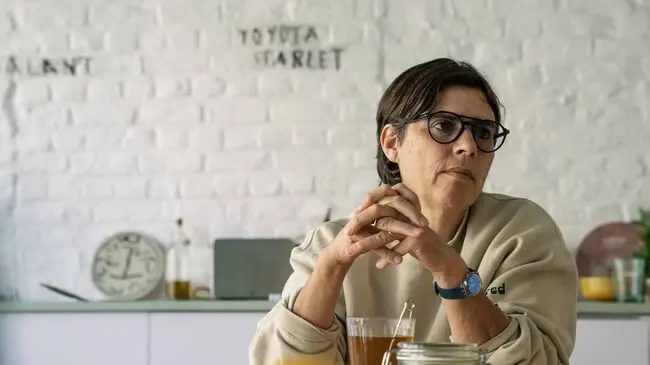In a few decades, people might not understand my work

A rotating camera that describes what it sees. Clay face detection. Real-time crime cams. A 24/7 sunset. A machine selling likes and followers. A clock that shows what percentage of your life is completed. This could be a leaked list of Netflix show pitches, but it’s not. New media artist Dries Depoorter works with technology, social media and our generational common knowledge, to create interactive installations online and in real life. In 2021, he made The Flemish Scrollers, a software analyzing the live streams of the Flemish Parliament and tweeting the politicians who are using their phones. 'Pls Stay Focused', the bot tweets and Instagram posts. Now, Dries brings his critical technological discussions to a new topic, joining other Belgian and international artists at iMAL for Swipe Right! Data, Dating, and Desire.
Can you explain to us what kind of art you make?
I call myself a new media artist. I make art with modern technology about several themes including surveillance, privacy, social media, machine learning… I try to approach these themes in a very playful manner: experimenting with different forms of media like apps, games or interactive installations.
It’s important that people who don’t have a particular connection to art can understand my work
The concept of my work should be short and sweet. I want to be able to explain every project in one simple sentence. I’m not really fond of complex discourse about art as it uses such niche vocabulary. It’s important that my parents, my friends and people in general, who don’t have a particular connection to art, can understand my work. If they ask me what I’m doing, I can say I’m making a machine that sells likes and followers, or I’m working on an installation that shows a 24h/7 real-time sunset and sunrise with the use of CCTV.


Quick Fix is the name of the machine selling likes and followers from bots. You install it in a museum context or a festival. Do a lot of people use the machine?
Actually, yes. A lot of people, of course, are curious to see if it actually works. And it does. After an exhibition, I sometimes check the data of the machine. When it was installed in the U.S.A, I noticed that one account paid 20 dollars to get more followers. Sometimes, the machine makes up to 250 euros in a day, that’s crazy.

You work around very present-day themes. Would you say your art comes from a fascination or indignation?
I try to avoid formulating direct opinions in my art. I experiment with my subject and the possible impacts on our society, but without a particular bias. I want to show the dangers of technology, but also its possibilities.
I want to show the dangers of technology, but also its possibilities


You’ve worked with and for multinationals. Do you find that there is a duality between that and working as an artist?
I studied electronics in high school, so I have a very technical background. After that, I went to study new media art at KASK in Ghent, which was something completely different. A technical education holds much more clear prospects for a future career than an artistic one. At art school, I was constantly wondering how I would make a living of this, how I would be able to live as an artist. I asked my teachers, but they could never really answer. The topic of money was completely taboo in art school. During my studies, I started working for a publicity agency, where of course the complete opposite is true: it’s all about money. I like that duality. It’s two completely different worlds. The art I make today is in limbo between those two worlds. It combines very different ways of thinking about materials, the message and the concept.


Do you have any particular style of working on the material?
Every time I get an idea or an insight, I write it down in iPhone notes. I categorize these notes as a good idea, a bad idea or an insight. Weeks or months later, I go through these notes again and put them together to create a concept. Sometimes the concept comes from two bad ideas and one good idea or one insight. I made Die With Me, a chat app that you can only use if you have less than 5% of battery. For a long time, that concept was just a pitch like ‘app for low battery’ in my notes.
For a long time, Die With Me was just ‘an app for low battery’ in my notes
What are some of the bad ideas in your Notes?
Oh [laughs], I should check those. [scrolls through his phone] An internet switch that looks like a normal switch but by which you turn off the internet. A Tinder trophy. Last used emoji. Something with Strava, the fitness app. I was thinking of software to add fake data with fake parkour and times and calories burned.

Artificial Intelligence is a highly discussed topic. Does AI scare you sometimes?
The fear of AI, but also the fascination for it, is something I’ve explored in my work Surveillance Speaker. That’s a camera that scans the room and describes what it sees. The voice that describes this is not a robotic voice but sounds very real. Some people thought that was a bit uncanny valley, or that there was a real actress somewhere behind a curtain. But there are also very funny glitches in the AI sometimes. There was once a set of twins at the exhibition, on which the camera said ‘I see a girl taking a selfie in the mirror’. I call that a poetic mistake.


How would you like future generations to look at your work?
I think about that a lot. For example, the app Die with Me. We know what it’s like to have a low battery or to have a dead phone. I wonder if future generations will still know this. Maybe there won’t be such a thing as a dead battery or maybe you will only have to charge them once a year. Then apps and concepts like this lose their relevance. People might not understand my work in a few decades. I’m not completely sure how to feel about that yet.

The media you work with are constantly evolving and adapting. Is it a race against the clock to keep your idea relevant?
For some projects, relevance is merely a matter of updating software. Other projects lose their power or wit over time when the hype is over or technology is outdated.
Tinderin was a project I made in 2015, comparing peoples Linkedin profile pictures to their Tinder profile. Five years later, there was the Dolly Parton challenge on the internet, in which everyone posted a collage of their Facebook, Instagram, Tinder and LinkedIn photos. Obviously, that takes away a lot of the power of the work. But that’s part of it, and that’s what keeps me moving forward. Whenever I get an idea that I think is really powerful, I immediately get to work. Someone might come up with a similar idea, so of course, I want to be the first to put it online. And who knows, the world might look completely different the next day.
Different Class works with the interest of their community at heart.
Our work’s purpose is to foster a solid network for independent artists, those who love them, and those who want to support them. Become a member to contribute to the local Belgian art scene.




